

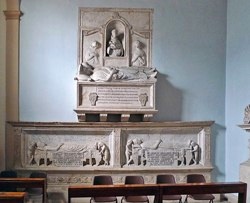
Right wall of the chapel
The 2nd chapel on the right of San Francesco, which was dedicated as the Cappella di Sant’ Antonio da Padova, was the funerary chapel of the Geraldini family from at least 1477, when Angelo Geraldini and his brothers commissioned the monument to their parents, Matteo and Elisabetta (see below). A number of other Geraldini monuments still survive here. The monument (1476) to Giovanni Geraldini, which was documented in this chapel in 1622, was subsequently removed and parts of it were recomposed in the Duomo: it is attributed to Agostino di Duccio.
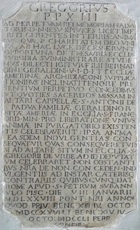
Monument to Matteo and Elisabetta Geraldini (1477)
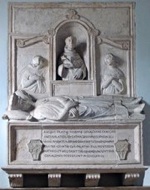
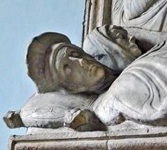
The monument on the right wall to Matteo (died 1471) and Elisabetta Geraldini is attributed to Agostino di Duccio. The inscription on the sarcophagus records that their eldest son, Angelo Geraldini (see below) and his brothers, Bernardino, Battista and Girolamo commissioned it in 1477. The effigies lie side by side on the sarcophagus, and reliefs of angels flank a bust of St Antony of Padua above.
Monument to Camillo Geraldini and Belissario Geraldini (ca. 1482)
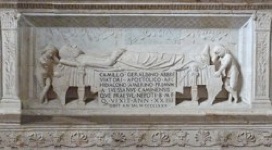
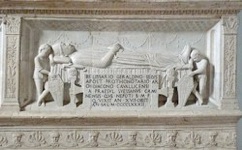
This double monument on the right wall commemorates the cousins Camillo and Belissario Geraldini. Each is depicted in effigy, with grieving angels at his head and feet. Each is identified in the inscription below as the nephew of Angelo Geraldini (see below), and it seems likely that Angelo commissioned the double monument. The respective inscriptions also record that:
-
✴Camillo, who was the first Archdeacon of Amelia, died in 1480 aged 24; and
-
✴Belissario, who was Archdeacon of Cavaillon (near Avignon), died in 1482 aged 17.
The work was inspired by the funerary monument (1477) of Raffaello della Rovere (the brother of Pope Sixtus IV) in Santi Apostoli, Rome by Andrea Bregno.
Monument to Angelo Geraldini (1486)
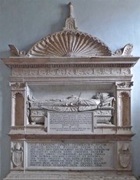
Other Geraldini Monuments
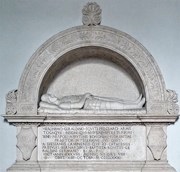
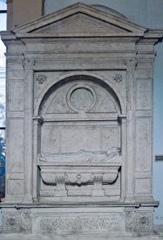
There are two other monuments on the back wall:
-
✴The monument to the left of the entrance commemorates Girolamo, who died in 1481, aged 39. He had acted as Podestà in a number of cities, including Norcia, Spoleto and Florence and subsequently served as a soldier under Braccio Baglioni. The epitaph records that the monument was commissioned by his surviving brothers, Angelo, Bernardino and Battista. He is depicted in armour, lying on the sarcophagus.
-
✴The monument to the right of the entrance commemorates Angelo II Geraldini, the son of Battista, who served as Bishop of Catanzaro, Calabria (1532-6) and died in 1548. His nephew Sforza, who succeeded as Bishop of Catanzaro in 1536-50, commissioned his monument.
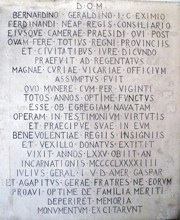
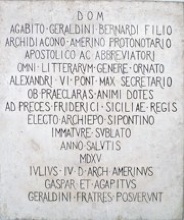
There are also two other memorials on the altar wall:
-
✴The epitaph on the left commemorates Bernardino,the brother of Angelo, who entered the service of King Ferrante I of Naples in ca. 1450. He retained his links with Amelia, often accepting public office there, including the traditional Geraldini post of Archdeacon of Amelia. He died in 1494, aged 75.
-
✴The epitaph on the right commemorates Agapito, Bernardino’s son. Pope Alexander VI appointed him as his secretary and as papal legate to Perugia and Umbria. His association with Cesare Borgia, the son of Alexander VI, began in 1498 when he organised the cortège that accompanied Cesare to France for his marriage to Princess Charlotte of Albret. Agapito then negotiated with King Francis I of France for financial support for Cesare’s campaign in the Romagna in 1500. Agapito was a witness to the murder of Cesare’s allies in 1503, and became Cesare's vicar in Perugia after the expulsion of the Baglioni soon after. With Cesare’s subsequent downfall, Agapito retired to private life. He died in 1515, aged about 65.
Read more:
This website on the Geraldini family contains interesting additional information.
Return to San Francesco.
Return to Monuments of Amelia.
Return to the Walk around Amelia.

